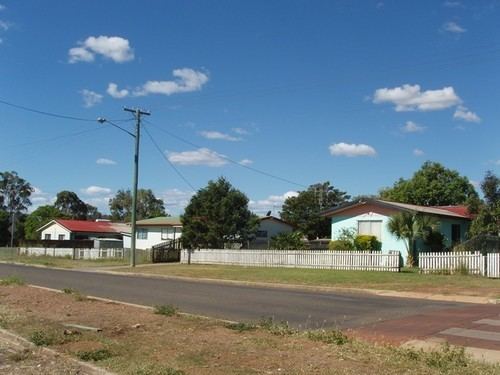Population 1,128 (2006 census) Postcode(s) 4605 Founded 1900 Local time Saturday 4:51 PM | Established 1900 State electorate(s) Callide Postal code 4605 | |
 | ||
LGA(s) Cherbourg Aboriginal Shire Council Weather 24°C, Wind E at 16 km/h, 75% Humidity University Southern Queensland Institute of TAFE | ||
Cherbourg (/ˈʃɜːrbɜːrɡ/, locally [ˈʃɜːbɜːɡ]) is a town in the South Burnett region of Queensland, Australia. It is located off the Bunya Highway approximately 250 kilometres (155 mi) north-west of Brisbane and 6 kilometres (3.7 mi) from the town of Murgon. It is situated very close to the dam wall of Bjelke-Petersen Dam. Attractions in Cherbourg include the 'Bert Button Lookout' and 'Emu Farm Tours'. At the 2006 census, Cherbourg had a population of 1,128.
Contents
- Map of Cherbourg QLD 4605 Australia
- History
- Governance
- Demographics
- Unemployment
- Education
- Notable former residents
- References
Map of Cherbourg QLD 4605, Australia
The town, formerly known as Barambah, was founded as a settlement for Aborigines in the early 1900s under a policy of segregation being pursued by the Government of Queensland. Its history has been described in at least two books, Dumping Ground by Thom Blake and Is That You Ruthie? by Ruth Hegarty.
History
In 1900, the Salvation Army negotiated for the establishment of the Barambah Aboriginal Reserve, which was gazetted over 7,000 acres (2,800 ha) on 23 February 1901. It was initially populated with a few local Aborigines, but others from the Esk region were soon sent to the reserve. Many were forcibly removed from their homes and "settled" at Barambah which was later renamed 'Cherbourg'. Sometimes they were sent there as punishment for refusing to work. People from 109 different areas were mixed together and they were not allowed to speak their own languages.
The reserve was administered by the Aboriginal Protection Society, Ipswich, until February 1905, when control passed to the Government of Queensland and a Superintendent was appointed, who reported to the Chief Protector of Aborigines. On 8 December 1931 the settlement was renamed Cherbourg. From 1905 until 1939, in total 1587 Indigenous people were removed to the settlement from all across the state.
The settlement housed a reformatory school and training farm, a home training centre for girls, a hospital, dormitories in which the women and children lived, and churches of various denominations. Training was provided in a variety of agricultural, industrial and domestic fields. People were hired out as cheap labour and at one stage they were not allowed to leave the reserve. In fact, until the referendum in 1967, the indigenous people at Cherbourg were not even counted in the census.
Cherbourg Post Office opened on 15 November 1965 and closed in 1986.
The effect of mixing these different groups of people together and forcing them to learn to speak a foreign language (English) has been an almost total loss of their cultural heritage. Many of the languages are considered to be extinct, surviving only in notes and recordings stored at the University of Queensland.
Governance
Over the years, the policies towards Aboriginals changed from protection to assimilation and eventually participation and a measure of self-government with the passage of the Community Services (Aborigines) Act 1984. The Act provided for elected community councils who could make recommendations to the Minister for Community Services on matters relating to the progress, development and wellbeing of the people they represented. On 28 August 1986 a Deed of Grant in Trust was granted to the Cherbourg community, giving this council official status. The Local Government (Community Government Areas) Act 2004 gave Cherbourg formal legal recognition as a local government.
Alcohol limits were imposed on Cherbourg residents in March 2009 in an attempt to reduce violence. Mayor Sam Murray claims the restrictions are not being enforced and the problem is being pushed underground. Early reports indicate that the bans have not reduced violent assaults in the town which are occurring 30 times more than the Queensland average.
Demographics
Cherbourg has a population of around 1241 persons, making it Queensland's third largest Aboriginal community. The town's main tribal groups are the 'Wakka Wakka' people and the 'gubbi gubbi' people In 2006, median individual income for residents of Cherbourg was $227 per week, less than half the national median. 98.8% of housing in the town is stand-alone houses.
Unemployment
The community participates in Work for the Dole scheme. Unemployment in the town is high as there is very little genuine work to be found in the town or in nearby Murgon. Results from 2006 census survey reported 31.4% of the workforce was employed full-time while 49.5% worked part-time and 5.8% were unemployed.
Education
Cherbourg is home to the Nurunderi (meaning taught by Great Spirit) campus of TAFE Queensland South West. It offers general courses of study as well as ones specific to Aboriginal and Torres Strait Islanders. All people are welcome to study at this campus.
